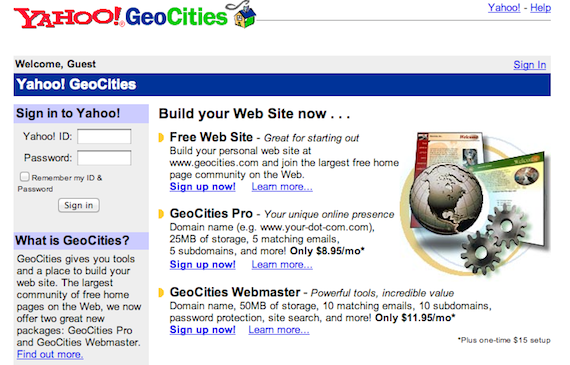Neuromarketing: Social Proofing on Landing Pages (Part 1)
Neuromarketing is one of those buzz terms used to describe a recent infatuation with new technology. It’s promise is simple. Consumers make buying decisions based on unconscious factors that are out of their control.
The purpose of neuromarketing is to anticipate unconscious reactions and provide the ultimate sales platform: an emotional and logical boot in the direction of your checkout cart.
It is a study driven by the emerging field of neuro web design.
When I look at the challenges facing web designers in 2012, I’m grateful that I never made a career out of it.
I still remember when web design was the bastard child of HTML and Geocities.
Life was simple, hosting was expensive.

The good old days, where hosting cost a kidney…
A decade has passed and still I have nightmares over my first website. It included football results, Angelina Jolie’s tits and the musings of my adolescence. Oh, and a guestbook.
The site was hosted by Freeserve with a CJB.NET domain. I thought it was the coolest shit ever. And so I vowed to become a web designer. Somehow I succeeded, for about 3 years.
Web development back then was simple. You learnt HTML, CSS and a programming language if you were feeling ambitious.
My, haven’t the times changed?
Just look at the new factors a designer must consider:
- Usability
- Accessibility
- Search engine optimisation
- Conversion optimisation
- Load times
- Bounce rates
- Subscription rates
- Sales
Perhaps the biggest headache of all is the emergence of neuro web design.
Designers are expected to cater visual aesthetics for unconscious decisions that the user doesn’t even know he’s making. Of course, the very best designers don’t need to be told. It’s an innate talent, their intuition.
Well, I am not a very good designer. And chances are, neither are you.
When I design a landing page, I want it to be powerful. I want it to drum my desired action in to the user’s head. And if there are ways to do this subconsciously, through neuromarketing, then I am all for getting my hands dirty.
I crave the blueprints to the ultimate ‘Venus Flytrap‘ Landing Page. The kind of sales pitch that gobbles you up whole, then spits you out minus your wallet.
This post (the first in a series) is as far as I have come in the quest for that landing page.
Some of the tips may seem like the hallmarks of a scumbag. Which is exactly what they are. Use them at your own discretion.
Social Proofing
You may protest that you don’t care what others think when making a purchase, but you do. It’s natural, and it’s healthy. I’ll go one step further. It’s evolution.
When we want to know how to behave, or how to act appropriately, we look to the crowd. If the crowd is glowing with praise, we are more inclined to look favourably on a product or service. If the crowd is standing still, or absent altogether, we are reluctant to make the first move.
Social proofing rule #1: Show the ball rolling. Whatever action you want the user to perform, make it clear that the action has been performed many times before.
Social proofing on the web comes in the form of reviews, testimonials and sharing metrics.
A hefty segment of the Fiverr ecosystem is built around webmasters like you and I trying to ‘seed’ their assets with fake fans, fake followers and fake comments. Why? It’s not for the sales. It’s for the implication to other real users that “Hey, Sherlock. There’s something going down over here worth knowing about.”
Attempts at social proofing can be rather uninspiring. And that is a massive danger. Consumers are not stupid!
For social proofing to be effective, it has to skip by the conscious mind without a red flag being raised.
When might a red flag be raised? How about when you view a product on Amazon and the only review is 5 stars from a contributor with the same name as the author? If this is your marketing plan, forget it. You’ll get better publicity by trapping your head in a bin and phoning the Gazette.
Social proofing rule #2: Look authentic. A hundred 5 star reviews from family and friends is much less authentic than a handful of ‘positively mixed’ reviews. Here’s something I tell people all the time: the most powerful testimonials in the world are those that address a minor weakness wrapped lovingly in glowing praise. The presence of the minor weakness acts as a decoy for any major weakness that could kill the sale. Be the one to choose your product’s perceived weakness (and then fix the real issue, duh!).
If you’re going to use a testimonial (or a dodgy review), seek one that tells a story.
A study conducted by Peter de Vries in 2007 found that while products with positive reviews yield a 20% better return than those with no reviews, the most effective reviews are those told as stories with a photo of the individual concerned.
A good testimonial will reveal background information, a relatable character (preferably with a photo) and, of course, a desired outcome. Testimonials that allow the reader to substitute himself in to the story are by far the most effective. Think about this before you add a throwaway one-liner to your page. Detail catches the worm.
Relate to the world they know.
Affiliate marketers are aware that one of the best ways to ramp up the effectiveness of a testimonial is to play a geographical mindfuck on the unsuspecting reader.
“Glowing testimonial of awesomeness, lorem ipsum. Your product saved my life!”
– John Doe, The User’s Town Here
There are many geo-detection scripts that can do this, with varying degrees of efficiency. One of the more popular tools is Maxmind.
There’s a catch.
Geodetection works a lot better in America than it does anywhere else in the world. The United States is scattered and sparsely populated in comparison to Europe. When I view a page with the Maxmind script, it refers to my current location as Barnet.
The distance between Barnet and Ruislip, my hometown, is only 13.3 miles. An accuracy window of 13 miles is likely to produce targeted advertising in America (or most of it). However, in London?
13.3 miles is the difference between China Town, Chelsea and the Queen’s palace. Actually, that’s about 1 mile.
Is it ethical to manipulate users with an illusion of locality? I’ll let you be the judge of that.
Social proofing rule #3: Get location specific, but only if the technology allows it. You don’t want an IP database billing you as Oxford’s Favourite Boat Manufacturer if your user is browsing from Cambridge.
Sharing is caring
Another popular form of social proofing is sharing metrics. You see them used, you’re aware of the potential abuse, but the anchor of perceived super-popularity is difficult to shake.
Mashable content draped in a thousand retweets somehow seems more valid than a forgotten essay from a university professor. And even if you can spot the human failure in this snap judgment, we both know which article you are more likely to read.

These social metrics create an illusion of popularity that will form the basis of your own opinion
Social proofing rule #4: Never share that nobody cares! If you are worried that people won’t share your sales pitch, you are probably right. It’s a social faux-pas. So include a separate page with ‘How to’ content. Aim to get this shared, then integrate it with the sales page. Never place sharing metrics on your sales page if the counters are set to zero. You are shooting yourself in the balls.
In the affiliate world, social sharing metrics are already being exploited. I’ve encountered dozens of ‘fake blogs’ where the content has been liked by 1000s of users. The Like counter is either forged as a JPG, or iFramed in from a genuine page.
As murky as the tactic is, it’s a symptom of a greater problem. Getting real customers to share and like your landing pages is not easy. In some verticals, the prospect sends a shiver down my spine.
Joe Bloggs is never going to publicise his fascination for ‘Fat Local Slags’ on Facebook. The gigantic elephant in the room is that many of the products we sell are not destined to be passed around and glorified virally.
I would suggest that different social metrics need to be used.
One of my favourite techniques combines social proofing with scarcity and a time constraint.
“There are currently [17] people viewing today’s offer.”
“[654] people have signed up since October 1st.”
“We have exceeded our capacity! The offer ends in X.”If you’re too late, don’t worry. We’ll be reopening our doors in December.
It’s aggressive, bruising and you will no doubt lose a few fans. But you will sell.
The final line is a tribute to one of the most successful ad writers in history.
Colleen Szot has made a career out of badgering Americans in to parting with their credit cards. An infomercial legend, she has sold over $10 billion in merchandise. Her power to relate to the couch potato is second to none.
Perhaps Szot’s greatest stroke of genius – and certainly the most famous – was a subtle wording change in one of her scripts. The television producers could barely lift their jaws from the floor when half of America jammed the phone lines, as if pulled by puppet strings.
When we aim to increase sales, we tend to look outward. We look for celebrity endorsements, glowing testimonials. We add to the hard-sell in our copy. Szot noted something much smaller, much easier to fix.
She changed three words and shattered a home shopping sales record that had stood for 20 years.
Want to know what she changed?
Version 1: Operators are waiting, please call now.
Version 2: If operators are busy, please call again.
Ca-ching.
I can’t recall a better testimonial for the power of social proof.
Social proofing rule #5: The smallest change can produce the most remarkable returns. Especially when they are directed at the unconscious mind. Scrutinise every last pixel of your landing page to ensure that it’s projecting the right message.
Check back next week for Part 2 in this Neuromarketing Series. Subscribe to my RSS here.
Recommended This Week
Be sure to check out Adsimilis, the official sponsor of Premium Posts Volume 5 & 6. Adsimilis is one of the most effective networks in the world for CPA affiliates. Lots of offers, lots of high payouts, lots of exclusives. Sign up now.

CJB.net, now that brings back memories. If only I can find the "Book of Life" website backup that I have…